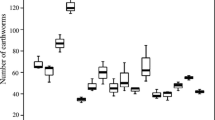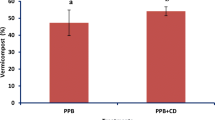Abstract
The study was conducted to determine the optimum storage time for vermicompost without significant loss of nutrients; nitrogen (N), phosphorous (P), and potassium (K). Cattle manure, paddy straw, municipal solid wastes, and fly ash were used for vermicompost preparations. The dynamics of N, P, and K in the vermicomposts were studied during 180 days of incubation at 28–32 °C. In general, N concentration increased in the first 90–105 days of incubation and then gradually decreased until the 180th day while P and K concentrations steadily decreased over the length of the study, with the rate of loss leveling off after 150 days. The rate of nutrient loss was directly related to the initial level, decreasing the fastest for the nutrients with the highest initial concentrations. Optimum storage times were substrate and N dependent.

Similar content being viewed by others
References
Barois, I., & Lavelle, P. (1986). Changes in respiration rate and some physo-chemical properties of a tropical soil during transit through Pontoscolex corethrurus (Glossoscolecidae, Oligochaeta). Soil Biology and Biochemistry, 18, 539–541.
Bhattacharya, S. S., & Chattopadhyay, G. N. (2002). Increasing bioavailability of phosphorus from fly ash through vermicomposting. Journal of environmental quality, 31, 2116–2119.
Bhattacharya, S. S., & Chattopadhyay, G. N. (2004). Transformation of nitrogen during vermicomposting of fly ash. Waste Management & Research, 22, 488–491.
Bhattacharya, S. S., Iftikar, W., Sahariah, B., & Chattopadhyay, G. N. (2012). Vermicomposting converts fly ash to enrich soil fertility and sustain crop growth in red and lateritic soils. Resource Conservation and Recycling, 65, 100–106.
Bhattacharyya, P., Pal, R., Chakrabarti, K., & Chakraborty, A. (2004). Effect of composting on extractability and relative availability of heavy metals present in Calcutta municipal solid waste. Archives of Agronomy and Soil Science, 50, 181–187.
Ciavatta, C., Govi, M., Simoni, A., & Seqi, P. (1993). Evaluation of heavy metals during stabilization of organic matter in compost produced with municipal solid wastes. Bioresource Technology, 43, 147–153.
Edwards, C. A., & Fletcher, K. E. (1988). Interaction between earthworms and microorganisms in organic matter breakdown. In C. A. Edwards (Ed.), Biological interactions in soil (pp. 235–247). New York: Elsevier.
Garg, P., Gupta, A., & Satya, S. (2006). Vermicomposting of different types of waste using Eisenia foetida: a comparative study. Bioresource Technology, 97, 391–395.
Golchin, A., Nadi, M., & Mozaffari, V. (2006). The effects of vermicompost produced from various organic solid wastes on growth of pistachio seedlings. Acta Horticulturae, 726, 301–306.
Goswami, L., Patel, A., Dutta, G., Bhattacharyya, P., Gogoi, N., & Bhattacharya, S. S. (2013). Hazard remediation and recycling of tea industry and paper mill bottom ash through vermiconversion. Chemosphere, 92, 708–713.
Goswami, L., Sarkar, S., Mukherjee, S., Das, S., Barman, S., Raul, P., Bhattacharyya, P., Mandal, N. C., Bhattacharya, S., & Bhattacharya, S. S. (2014). Vermicomposting of tea factory coal ash: metal accumulation and metallothionein response in Eisenia fetida (Savigny) and Lampito mauritii (Kinberg). Bioresource Technology, 166, 96–102.
Gupta, S. K., Tewari, A., Srivastava, R., Murthy, R. C., & Chandra, S. (2008). Potential of Eisenia foetida for sustainable and efficient vermicomposting of fly ash. Water Air & Soil Pollution, 163, 293–302.
Kaviraj Sharma, S. (2003). Municipal solid waste management through vermi-composting employing exotic and local species of earthworms. Bioresource Technology, 90, 169–173.
Kumar, R., Verma, D., Singh, B. L., & Kumar, U. (2010). Composting of sugar cane waste by products through treatment with microorganisms and subsequent vermicomposting. Bioresource Technology, 101, 6707–6711.
Majlessi, M., Eslami, A., Saleh, H. N., Mirshafieean, S., & Babaii, S. (2012). Vermicomposting of food waste: assessing the stability and maturity. Iranian Journal of Environment and Health Science, 9, 25–30.
McInerney, M., & Bolger, T. (2000). Temperature, wetting cycles and soil texture affects on carbon and nitrogen dynamics in stabilized earthworm casts. Soil Biology and Biochemistry, 32, 335–349.
Ndegwa, P. M., & Thompson, S. A. (2000). Effect of C and N ratio on vermicomposting in the treatment and bioconversion of biosolids. Bioresource Technology, 76, 7–12.
Page, A. L., Miller, R. H., & Keeney, D. R. (1982). Methods of soil analysis (Part 2). Madison: American Society of Agronomy.
Singh, D., & Suthar, S. (2012). Vermicomposting of herbal pharmaceutical industry waste: earthworm growth, plant-available nutrient and microbial quality of end materials. Bioresource Technology, 112, 179–185.
Suthar, S. (2010). Recycling of agro-industrial sludge through vermitechnology. Ecological Engineering, 36, 1028–1036.
Suthar, S., Mutiyar, P. K., & Singh, S. (2012). Vermicomposting of milk processing industry sludge spiked with plant wastes. Bioresource Technology, 116, 214–219.
Triphathi, G., & Bhardwaj, P. (2004). Decomposition of kitchen waste amended with cattle manure using an epigeic species (Eisenia fetida) and an anecic species (Lampito mauritii). Bioresource Technology, 92, 215–218.
Verma, A. (2011). Biology of earthworms. Chapter 13, Springer, Berlin, pp. 215–228.
Yadav, A., & Garg, V. K. (2011). Recycling of organic wastes by employing Eisenia fetida. Bioresource Technology, 102, 2874–2880.
Author information
Authors and Affiliations
Corresponding author
Rights and permissions
About this article
Cite this article
Das, D., Powell, M., Bhattacharyya, P. et al. Changes of carbon, nitrogen, phosphorous, and potassium content during storage of vermicomposts prepared from different substrates. Environ Monit Assess 186, 8827–8832 (2014). https://doi.org/10.1007/s10661-014-4046-5
Received:
Accepted:
Published:
Issue Date:
DOI: https://doi.org/10.1007/s10661-014-4046-5




